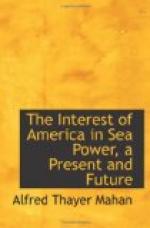Between and separating these two groups, of primary bases and advanced posts, extends the chain of positions from Yucatan to St. Thomas. As far as is possible to position, apart from mobile force, these represent control over the northern entrances—the most important entrances—into the Caribbean Sea. No one of this chain belongs to any of the Powers commonly reckoned as being of the first order of strength.
The entrances on the north of the sea, as far as, but not including, the Anegada Passage, are called the most important, because they are so few in number,—a circumstance which always increases value; because they are so much nearer to the Isthmus; and, very especially to the United States, because they are the ones by which, and by which alone,—except at the cost of a wide circuit,—she communicates with the Isthmus, and, generally, with all the region lying within the borders of the Caribbean.
In a very literal sense the Caribbean is a mediterranean sea; but the adjective must be qualified when comparison is made with the Mediterranean of the Old World or with the Gulf of Mexico. The last-named bodies of water communicate with the outer oceans by passages so contracted as to be easily watched from near-by positions, and for both there exist such positions of exceptional strength,—Gibraltar and some others in the former case, Havana and no other in the latter. The Caribbean, on the contrary, is enclosed on its eastern side by a chain of small islands, the passages between which, although practically not wider than the Strait of Gibraltar, are so numerous that entrance to the sea on that side may be said correctly to extend over a stretch of near 400 miles. The islands, it is true, are so many positions, some better, some worse, from which military effort to control entrance can be exerted; but their number prevents that concentration and that certainty of effect which are possible to adequate force resting upon Gibraltar or Havana.
On the northern side of the sea the case is quite different. From the western end of Cuba to the eastern end of Puerto Rico extends a barrier of land for 1200 miles—as against 400 on the east—broken only by two straits, each fifty miles wide, from side to side of which a steamer of but moderate power can pass in three or four hours. These natural conditions, governing the approach to the Isthmus, reproduce as nearly as possible the strategic effect of Ireland upon Great Britain. There a land barrier of 300 miles, midway between the Pentland Firth and the English Channel—centrally situated, that is, with reference to all the Atlantic approaches to Great Britain—gives to an adequate navy a unique power to flank and harass either the one or the other, or both. Existing political conditions and other circumstances unquestionably modify the importance of these two barriers, relatively to the countries affected by them. Open communication with the Atlantic is vital to Great Britain, which




